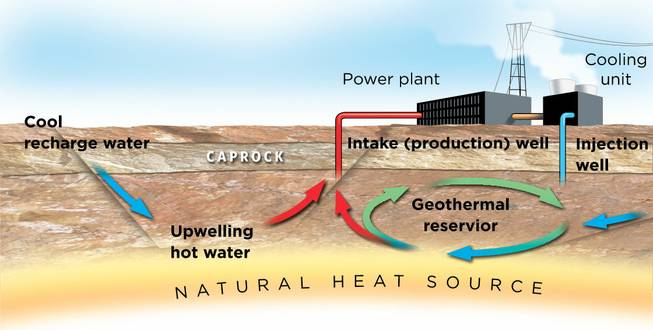
As dry as Nevada may seem, there is still considerable water in the rock below, recharging the reservoirs of water that exist in the stone, like water in a sponge. Injection wells force the now-hot water to find an outlet — the intake well. Geothermal fluids (hot water) are brought to the surface through production wells, some as deep as 2 1/2 miles. The steam drives turbines in the power plant.
Monday, March 16, 2015 | 2 a.m.
↪
Humans have been using geothermal energy for more than 10,000 years, since American Paleo-Indians used hot springs for cooking, bathing and cleaning. But it wasn’t until 1904 that the first geothermal electric power plant was invented to generate electricity, when Italian scientist Piero Ginori Conti figured out how to turn steam into power.
The amount of heat in the top 33,000 feet of the Earth’s surface contains 50,000 times more energy than all of the oil and natural gas resources in the world.
Worldwide, geothermal power plants produced more than 11,700 megawatts of electricity, enough to meet the annual needs of more than 6 million typical U.S. households. The first geothermal plant in the United States debuted in 1992, and now, two decades later, 69 geothermal plants operate nationally. Several are in Nevada, and more are coming.
WHERE IS GEOTHERMAL ENERGY POSSIBLE?
Nevada
■ As of 2013, there were 29 operating geothermal power plants in Nevada producing 518 megawatts of electricity. By 2016, plants producing another 834 megawatts are expected to come online.
■ There are about 60 hydrothermal sites statewide that can be used with existing technology to generate geothermal energy.
■ Geothermal power plants are online or planned for the following counties: Humboldt, Mineral, Esmeralda, Churchill, Pershing, Washoe, Lander, Elko, and Nye, as well as the Pyramid Lake Paiute Tribe Reservation.
■ Northern Nevada produces roughly 7 percent of its power from geothermal sources because heat from deep, hot water with temperatures above 212 degrees Fahrenheit rises through faults in the Earth's surface. Improving technologies, required to produce more electricity, could extract more heat from circulating ground water and increase Nevada's potential power production from renewable energy sources.
Nationally
The United States produces the most geothermal energy in the world — 17 billion kilowatts in 2013, or 0.4 percent of the country’s total electricity. All of it is made in eight states.
Worldwide
A sampling of geothermal power plants around the world
1. Tongonan Geothermal Power Plant, Philippines. It returned to service last year after being damaged by a 2013 typhoon.
2. Hellisheiði Geothermal Plant, Iceland. It sits along an active volcanic ridge and provides homes and businesses with electricity and hot water for space heating.
3. Miravalles III Geothermal Power Plant, Costa Rica
4. Larderello Geothermal Power Station, Italy
5. Wairakei Geothermal Power Plant, New Zealand
6. Cerro Prieto II Geothermal Plant, Mexico
7. Olkaria II Geothermal Power Station, Kenya
8. Berlin Geothermal Power Plant, El Salvador
HOW GEOTHERMAL ENERGY IS GENERATED
■ Workers drill wells into geothermal reservoirs, where water heated by magma sits relatively close to the earth’s surface. Such hot spots typically are found in areas with active or geologically young volcanoes and lots of seismic activity. Nevada has hundreds of hot spots, mostly in the north.
■ Production wells carry hot water from the reservoir to a power plant; injection wells return the water to the reservoir.
■ At the power plant, the hot, pressurized geothermal fluid expands, causing resulting steam to turn the blades of a turbine. The rotating turbine shaft spins magnets inside a large coil, which creates an electrical current.
■ The current in the generator is sent to a transformer outside the plant, where voltage is increased and transmitted over power lines to homes and businesses.
THE COSTS
Geothermal power plants cost more to build than natural gas plants, but the two become economically comparable over time because of the massive amount of fuel needed to operate natural gas plants.
PROS
Geothermal energy is renewable. If reservoirs are managed properly, the rate of energy extraction can be balanced with the reservoir’s natural heat recharge rate.
Geothermal energy is clean. Geothermal plants don’t emit greenhouse gases and use less water than most power-generating systems.
Geothermal power plants can generate electricity 24 hours a day. Bad weather doesn’t impede production.
CONS
Geothermal power plants are feasible only in specific locations where hot spots exist.
Geothermal power plants can impact the stability of land and, in extreme cases, cause earthquakes.
The initial costs of building geothermal power plants and installing geothermal heating and cooling systems can be steep.
GEOTHERMAL AT HOME
Geothermal systems aren’t limited to large power plants. Homeowners and businesses can install residential geothermal heat pump systems to produce heat in winter and cold air in summer. They work in tandem with existing heating and cooling systems and can be installed anywhere; no hot spots are needed.
The heat pumps take advantage of the fact that shallow ground remains at a constant temperature — about 68 degrees year round. In winter, the system of tubes drilled a few hundred feet down absorbs heat from the ground and distributes it to a building through a conventional duct system. In summer, the system transfers heat from the building to the underground piping loop, where it is cooled by the Earth.
Installing a geothermal heat pump in a 2,500-square-foot home costs about $25,000. That’s close to double the price of a conventional system, but geothermal systems can reduce utility bills by up to 70 percent. Savings come quicker in bigger buildings, making the systems especially suitable for schools, apartments and government buildings.
Chris Morris contributed the graphics to this story.

Join the Discussion:
Check this out for a full explanation of our conversion to the LiveFyre commenting system and instructions on how to sign up for an account.
Full comments policy